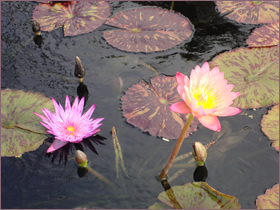“The conditions right now are the conditions we need for our work. It is not a matter of waiting until the conditions are better, when the situation is calmer when we have more time, or more information. Now, in the midst of our daily life, engaged in our professions and households, we can and should undertake the practice of yoga. If not now, when?”
The Wisdom of Patanjali’s Yoga Sutras
When I meet privately with a student interested in personal practice, we discuss health issues. Then I ask two questions.
How much time do you want to give or do you have to do your practice?
Often the student’s answers are questions. When is the best time to do my practice? How long should I practice?
To answer these questions the student and I must look at several factors together. First of all, the yoga practice must be appropriate for the needs of the person. For example, a person asks for a practice to help with sleep issues. Obviously, then, it would be logical to have a yoga practice to do before bedtime. Another person may find their energy is low, and it is difficult to get started in the morning. Then a morning yoga practice would be logical.
The student’s life is another factor to consider in finding a time to practice. A stay-at-home mom who must be up to make breakfast and see children off to school might find 10 am to be a good time for yoga; another person might find early morning or after work to be a better time; another might find evening, before bed, to be ideal.
A student must also think realistically about the time available to do a practice. It does not benefit a person to have a practice taking 30 minutes to do if realistically they have only 15. Remember, the real benefits of yoga come only over time, but require consistent practice.
The great yogi Krishnamacharya is said to have preferred a student to do five minutes of yoga everyday over a two-hour practice once a week. So the consistency of the practice is very important. Yoga Sutra I.14 tells us our yoga practice, first of all, must be appropriate for us and then be followed consistently over a long period of time.
Yoga is meant to fit our lives. Just as we would not force ourselves into some idealized yoga pose, we do not need to twist our lives around in order to have a yoga practice. But, if yoga is to serve us and become part of our life, then we must commit ourselves to a consistent practice.
So, if you believe yoga can benefit you and support you in living a healthier, more focused, and peaceful life, what is keeping you from starting now?
If you would like to talk about having a yoga practice tailored for your needs, please contact me. I am happy to meet and talk about yoga and explore your interest.
 I love designing salads. As paints are for an artist, the colors of lettuces and greens, carrots and beets, scallions and persimmons, olives and peppers, corn and peas, tomatoes and cucumbers, apples and oranges, strawberries, nuts, dates, raisins, and cranberries are my palette. I think about how their tastes and textures, as well as colors, create a beautiful, delicious, and healthful balance. But the salad is never complete until I have decided upon the perfect combination of vinegars and olive oils, enhanced with garlic, herbs, salt and pepper, to impart a glow to the greens.
I love designing salads. As paints are for an artist, the colors of lettuces and greens, carrots and beets, scallions and persimmons, olives and peppers, corn and peas, tomatoes and cucumbers, apples and oranges, strawberries, nuts, dates, raisins, and cranberries are my palette. I think about how their tastes and textures, as well as colors, create a beautiful, delicious, and healthful balance. But the salad is never complete until I have decided upon the perfect combination of vinegars and olive oils, enhanced with garlic, herbs, salt and pepper, to impart a glow to the greens.  Today at my family’s Labor Day picnic, my niece, an avid gardener, showed me a tomato-devouring hornworm. Bright green, about three inches long, and fat from having feasted on my brother-in-laws tomato plant. He was big enough to see even the detail of his mouth and the aphids that had taken up residence as parasites. I loved seeing him in all his brilliant green detail even while hoping my tomatoes would escape his attentions.
Today at my family’s Labor Day picnic, my niece, an avid gardener, showed me a tomato-devouring hornworm. Bright green, about three inches long, and fat from having feasted on my brother-in-laws tomato plant. He was big enough to see even the detail of his mouth and the aphids that had taken up residence as parasites. I loved seeing him in all his brilliant green detail even while hoping my tomatoes would escape his attentions.  Yoga is about being present for our experience, whatever it might be – a yoga pose, a conversation with a friend, an emotion. This is not easy. Our minds tend to wander. We often judge our own behaviors and vulnerabilities and seek to escape from our discomfort.
Yoga is about being present for our experience, whatever it might be – a yoga pose, a conversation with a friend, an emotion. This is not easy. Our minds tend to wander. We often judge our own behaviors and vulnerabilities and seek to escape from our discomfort. No, I am not a thief, but…
No, I am not a thief, but…